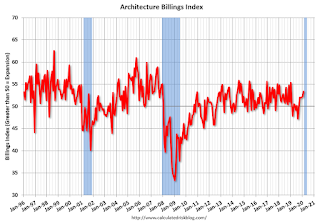by Calculated Risk on 3/18/2020 11:07:00 AM
Wednesday, March 18, 2020
AIA: Architecture Billings Index increased in February, Expected to decline rapidly
Note: This index is a leading indicator primarily for new Commercial Real Estate (CRE) investment.
From the AIA: Design services saw increase in February but economic footings are rapidly shifting
Demand for design services in February increased at a solid pace for the sixth month in a row, according to a new report today from The American Institute of Architects (AIA).
AIA’s Architecture Billings Index (ABI) score of 53.4 for February reflects an increase in design services provided by U.S. architecture firms (any score above 50 indicates an increase in billings). During February, both the new project inquiries and design contracts scores moderated slightly but remained in positive territory, posting scores of 56.5 and 52.0 respectively.
“Business conditions at architecture firms have been surprisingly positive so far this year. However, firms were just beginning to feel the impact of the dramatic slowdown caused by COVID-19 as this survey was being conducted in early March.” said AIA Chief Economist, Kermit Baker, Hon. AIA, PhD. “The rapid pull-back in activity throughout the economy will obviously be felt in the design and construction sector, and architecture firms will be one of the first to see how these events play out.”
...
• Regional averages: South (56.7); West (52.1); Midwest (51.3); Northeast (45.3)
• Sector index breakdown: mixed practice (51.6); commercial/industrial (51.5); multi-family residential (51.2); institutional (51.1)
emphasis added
 Click on graph for larger image.
Click on graph for larger image.This graph shows the Architecture Billings Index since 1996. The index was at 53.4 in February, up from 52.2 in January. Anything above 50 indicates expansion in demand for architects' services.
Note: This includes commercial and industrial facilities like hotels and office buildings, multi-family residential, as well as schools, hospitals and other institutions.
According to the AIA, there is an "approximate nine to twelve month lag time between architecture billings and construction spending" on non-residential construction. This index has been positive for 8 of the previous 12 months, suggesting some increase in CRE investment in 2020.
However, this will all change in the next survey - when activity will decline significantly.


